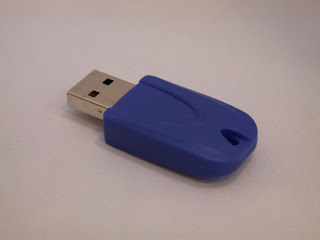Software Dongles
 There has been some criticism of Toon Boom’s decision to use software dongles for Storyboard Pro and Digital Pro (originally known as Solo).
There has been some criticism of Toon Boom’s decision to use software dongles for Storyboard Pro and Digital Pro (originally known as Solo).For those of you unfamiliar with Software dongles, a dongle is a small piece of hardware which plugs into the computer to enable the software to run. Typically, it is a small USB plug which unlocks the software.
Note that Toon Boom’s main consumer product, Toon Boom Studio, does not have a dongle. It simply uses a serial number to unlock the software, but there is no “activation” such as software like Windows Vista.
I am normally not a fan of dongles, but for software in the price range of Storyboard and Solo/Digital Pro, I take the dongle as a necessary evil.
In defense of the dongle, let me make these points:
1. Animation software at the level and cost of Storyboard Pro and Solo\Digital Pro has a relatively small user base and is expensive to create. These are professional level products. Specialized software is always expensive.
2. Studio, an amazingly capable and complete software package, comes with no dongle. It also has an amazing price, given its capabilities. Despite its amazingly low price, it is also heavily pirated. The frequent updates on this product place the pirate users at a a disadvantage, but I would be highly distressed if my livelihood depended only on this product. I know the arguments of pirate users simply trying out software that they would never buy, but in this case, I believe Toon Boom is losing sales to the pirates. Each copy’s serial code allows Toon Boom to track the original offender, but the legal hoops needed to prosecute the initial pirate are overwhelming.
3. Another option is to tie the software to the hardware, sort of like Adobe Premiere. The problems with this are multiple:
a. I use my animation software on multiple machines. Obviously, I don’t do this all at the same time. I draw on my Tablet PC. I tend to organize and paint my animations on my desktop PC with its massive screen. When I’m traveling light, I use a tiny Fujitsu tablet PC with an 8 inch screen to draw animations. Using a dongle is simple. I simply move the dongle from machine to machine. This complies with the software agreement, since removing the dongle effectively uninstalls the software from the machine.
b. If I had to work with a set-up like Adobe Premiere, I could never do this. I would need to buy at least three separate copies of the software, even though I am just one user, using one version at a time. The activation process would require a lengthy tech support call the moment I uninstalled the software from one machine to move it to another machine. Plus, the total uninstall and then install process is very time and hassle intensive.
c. I am also frequently changing my main PC’s hardware. A few months back, my hard-drive became too small, so I backed it up to an image, installed a new drive, and then installed the image. Much to my distress, several copies of my various programs were inactivated because I changed my machine’s configuration. Talk about substantial delays! Again, with a dongle, this is not a problem.
4. In essence, these pieces of software, which require complex activation schemes, also have a physical dongle: Certain components of your machine. Admittedly, these components are tough to lose and if you lose them, your hassle is not $250. It is simply hassle on the phone.
5. The other makers of high level animation software also have dongles. Toon Boom is not alone. For instance, Mirage (now TVPaint) also has a dongle.
6. EVERY piece of software that I use with a retail price approaching $1k or more has a dongle, using either a physical device or components of the machine, via complex activation schemes. Have you installed Microsoft Office lately?
My criticism of dongles:
1. For a laptop, dongles are a pain. They stick out and invite damage to the machine and the dongle.
2. The risk of loss makes me very paranoid.
3. The size of the Toon Boom dongles are tiny, meaning they are easy to lose. However, they do have the capabilities of being attached to a string or key-chain, such as with a typical flash memory drive. I have gone so far as to attach my dongles to such a string and add an attached old copy of my driver’s license. This makes it very difficult to lose the dongle.
4. If every software manufacturer demanded dongles, computing would become a major pain. Toon Boom recognizes this and limits the dongles to software that costs close to $1k or more.
In the end, as a business person, I accept that the dongle is inevitable with such a high level program. Frankly, now that I’ve paid a significant amount of money to buy the program, I get very angry at the thought that pirates might distribute such a program. Even a few lost sales of Solo or Storyboard Pro translate into many, many dollars.
Since, it is in my best interest for Toon Boom to be a very successful company, I put up the dongle.


Comments